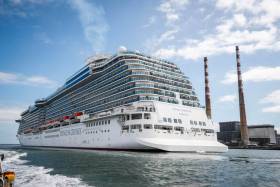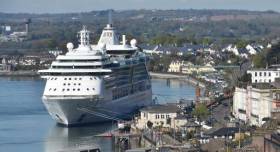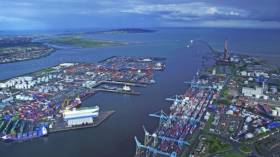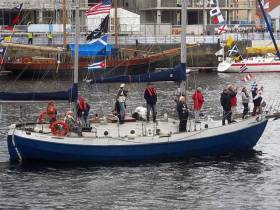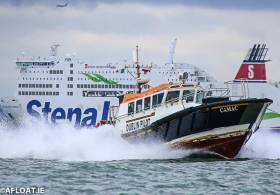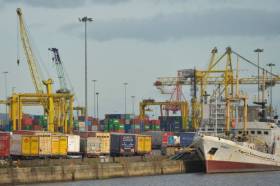Displaying items by tag: Dublin Port
Dublin Town, the not for profit organisation charged with creating a welcoming and economically viable city environment in Dublin, has urged Dublin Port to reconsider its decision to cut cruise ship calls to the city by more than 50%, from 172 in 2018 to 80 in 2021. Between March and October, the country will receive almost 200,000 visitors from cruise ships stopping in Dublin Port, before moving on to destinations like Cobh, Waterford and Belfast.
Richard Guiney, CEO of Dublin Town, said about the move: “In the coming days, Ireland will welcome the first cruise ship of the season to Dublin Port. This growing trade has come from a standing start to now adding between up to €35m to the local economy. However, all this has now been put in jeopardy by Dublin Port’s decision to drastically cut the number of passenger ships coming into the capital by more than 50 percent from 2021; a decision that we believe must be reversed.
“The move will have disastrous consequences for tourism in the city. However, it won’t just be Dublin that will suffer from this decision. It is likely that the number of cruise calls will dramatically drop across all Irish ports as a result of Dublin Port’s plans to deny access to the capital. If cruise operators remove Ireland from their itineraries now, it could prove virtually impossible to win them back. By sending out this message, Ireland may end up losing this vital resource forever.
"Dublin Port has an essential role in supporting the growing tourism sector in Ireland"
“Dublin Port has an essential role in supporting the growing tourism sector in Ireland and has established the city as a valued destination for the international cruise industry. In 2013, 102 cruise ships docked in Dublin, in 2019 it will be 172. Indeed, there is every indication that we could rival the 300 ships visiting Copenhagen in the coming years, thereby growing visitor spend to well more than €50m and more per annum.”
“Dublin has also grown its homeporting business, where ships both begin and end their journeys in Dublin, adding hotel bed nights and extended Irish stays to the passenger itinerary. This greatly increases visitor spend within the Irish economy. Homeporting in Dublin began in 2018 and was expected to reach 22 ships in the coming years.
“DublinTown has found that the ships’ crews are spending both time and money in the city, particularly when Dublin is the home port. Crews can be found seeking out essential supplies while here, spending their free time visiting clothes shops and enjoying the city. Failte Ireland has set the ambitious but achievable target to double Dublin’s tourist numbers by 2025. However, this target becomes much taller when we restrict access and send a message that tourists are not valued.
“Dublin Town has Visitor Assistants on each of the cruise ships that visit Dublin. This personnel assist passengers in maximising their short stay here. 45% of cruise ship passengers will have pre-booked excursions leaving from Dublin Port. The feedback from our cruise visitors is exceptional and represents an opportunity for Dublin to encourage those passengers back for a longer city break in the fair city. The key to growing our valuable tourism numbers lies in encouraging them to sample more of the city offering and adding to their ‘must see’ lists for their second and subsequent stays. Cruise tourism certainly facilitates this pattern.”
“The city has come to rely on cruise ship tourists and, at a time when Brexit has brought a decline in tourist numbers from Britain to Ireland, it is important that Dublin Port works with the rest of the city to increase the flow of passengers rather than curtail it. Dublin is in a unique position as the proximity of the port to the city means we can offer access for passengers in a way that other European capitals cannot rival. In this context, we must look at how we use our infrastructure to our national advantage. If Dublin Port believes that it has more freight traffic than it can accommodate then Government has a role to step in and facilitate its transfer to other ports. This must be done in the context of the national interest and not in the interests of one infrastructure provider. Ireland has for too long had a tradition of silo thinking which has held us back. We need to consider the bigger picture and assess how we can grow our national economy, and both create and sustain employment. Tourism in general and cruise ship tourism, in particular, have important roles to play in this regard.
“At DublinTown, we urge Dublin Port to work with the Irish Government and the cruise industry to build cruise tourism sustainably across Ireland. Minister Ross must be concerned about the impact this will have on his portfolio. Having overseen the increase in VAT from 9% to 13.5%, maintaining this important and growing element to the tourism package in Dublin will be an important element of the Minister’s legacy. Here is the perfect opportunity to show that he can help the industry grow.”
Boss of Port of Cork Warns Cork Tourism Could Suffer from Dublin's Cruise Ship Crisis
#portofcork - Chairman of the Port of Cork has warned that the lucrative cruise tourism sector on Leeside could take a serious hit because of Dublin Port’s decision to halve its cruise ship business.
As EchoLive.ie writes, John Mullins said a predicted leap in the number of cruise passengers visiting Cork and plans for further investment in the sector have been put at risk following the shock announcement in recent days.
Dublin Port has revealed plans to reduce the number of cruise ships allowed into the capital from 160 this year to 80 in 2021 because of the need for increased capacity for container traffic when the UK leaves the EU.
Mr Mullins said this could have a worrying impact on the cruise trade in Cork.
Click here for more.
Faroese-Flagged Caller to Dun Laoghaire Harbour Highlights Capacity Constraints in Dublin Port
#dublinbay- A unusual caller to Dun Laoghaire Harbour is a Faroese Islands flagged research survey vessel that is docked in the port due to berth capacity restrictions in neighbouring Dublin Port, writes Jehan Ashmore.
The 55m RSV Franklin which is listed on the Faroese International Ship Register, had arrived to the harbour just over a week ago having berthed alongside Carlisle Pier. There are currently 92 vessels owned on the islands which are a self-governing archipelago that form part of the Kingdom of Denmark.
This is not the first time ships in Dublin Port have been forced to use a berth in Dun Laoghaire Harbour as most recently, the Dutch flagged dredger Freeway as Afloat reported made a request late last year to enter the port and avail of a berth.
It was ironic that the trailing suction dredger which was carrying out works on behalf of Dublin Port had to spend a lay-over period in Dun Laoghaire Harbour. On that occasion during late December and into the New Year, the 92m vessel had also occupied Carlisle Pier due to the limited capacity available in the capital port.
As also previously reported on Afloat, last month Dublin Port announced that due to rising freight volumes and the need to create space due to Brexit, prioritisation of freight over tourism is to take place. The decision by Dublin Port to curtail cruiseships in using its facilities from 2021 has raised concerns among the wider Irish tourism industry.
In addition the proposed cruise-berth for Dun Laoghaire unveiled almost four years ago, is among a trio of multi-million euro projects that have been thrown into question by Dún Laoghaire-Rathdown County Council which cited both lack of funds and viability.
The south Dublin Bay harbour was under the control of Dun Laoghaire Harbour Company until a transfer took place last year to the local authority.
Since Stena Line withdrew the HSS fastferry service to Holyhead, Wales in 2014, the port has no major anchor tennant. It was 25 years ago that the operator chartered in another Faroese-flagged vessel Smyril Line's ferry Norröna (built 1973) which was a highly unusual move, given historically other ferries would of been pooled from Stena's extensive fleet.
The only vessels currently calling to the harbour on a year-round basis is the fleet of the Naval Service and ILV Granuaile, the aids to navigation tender belonging to Irish Lights which has its headquarters located on the harbour waterfront.
As for the 1,178 tonne RSV Franklin which is expected to depart the harbour by the end of this week.
New Dublin Port Customs Check Posts Will Be ‘Pinch Point’ Says CEO
New customs checkpoints in Dublin Port are expected to be a ‘pinch point’ for hauliers, according to the port company’s chief executive.
Eamonn O'Reilly tells RTÉ News that delays are likely to result from the new border inspection posts as Brexit would see a dramatic overnight increase in non-EU trade.
The new checkpoints are the first to be built in the port for decades, as their necessity waned in the 1990s thanks to free trade within the EU.
As previously reported on Afloat.ie, all sea freight requiring checks post-Brexit will be inspected at a 13,000m warehouse formerly owned by businessman Harry Crosbie.
Two of my favourite waterside places along the Liffey are in Dublin Port – Ringsend and Poolbeg.
The maritime history of Ringsend is part of the marine story of Ireland, an area resonant of seafaring history and Poolbeg Yacht and Boat Club is a place where, whenever I have been there, has always been welcoming, with a warm friendship of the sea.
They are both connected with a marine project which shows how the sea can influence lives in a very positive way, reaching out to those who may not have had any previous connection with it.
"The maritime history of Ringsend is part of the marine story of Ireland"
The 42 ft. ketch, the Rinn Voyager, is well known and has impressed me when I’ve seen her at Poolbeg. But she is much more than just a nice boat. She is the maritime face of a project which has helped to preserve marine skills and rehabilitated marginalised, disadvantaged people and recovering addicts. More than 7,000 users of the Drugs & Alcohol Task Force have benefited from the project. It is the embodiment of positive community and social activism. Dublin Port, with its programme of reaching out to the community, has been a strong supporter. FáS supported the project and so did many others and unemployed people, people with boat-building skills and school leavers built it. As a result, skills were maintained, passed on to younger people. Twenty-five years since it was launched, when the Rinn Voyager Sailing Project began, one of the hopes would be for a second vessel like the Rinn Voyager to increase the reach of the project.
Listen to the Podcast below as Denis Murphy describes what this special vessel, the Rinn Voyager, has achieved.
Dublin's River Liffey 'Dockers Taxi' Will Operate From February
As Afloat.ie reported earlier, the No.11 Liffey Ferry aka the “dockers’ taxi” is back in service after 35 years following a restoration project involving Richie Saunders of Ringsend, the Irish Nautical Trust, Dublin Port Company and Dublin City Council.
It is the first time the boat has been in service since 1984 to taxi the public north and south of the river, with each crossing to cost €2 starting 11th February 2019.
 NEW ERA FOR THE NO.11: Richie Saunders, of Ringsend, Lord Mayor of Dublin Nial Ring; CEO of Dublin Port Company Eamonn O’Reilly; and Jimmy Murray of the Irish Nautical Trust at the blessing of the No.11 Liffey Ferry which is back on the water after 35 years to ferry people north and south of the river in a new joint project between Dublin Port Company and Dublin City Council, run by the Irish Nautical Trust in aid of a new maritime training programme
NEW ERA FOR THE NO.11: Richie Saunders, of Ringsend, Lord Mayor of Dublin Nial Ring; CEO of Dublin Port Company Eamonn O’Reilly; and Jimmy Murray of the Irish Nautical Trust at the blessing of the No.11 Liffey Ferry which is back on the water after 35 years to ferry people north and south of the river in a new joint project between Dublin Port Company and Dublin City Council, run by the Irish Nautical Trust in aid of a new maritime training programme
Dublin Port’s Cargo Volumes Grow by 4.3% for the Second Year in a Row
Dublin Port Company has today reported full-year trading figures for 2018. The latest figures show that cargo volumes through Dublin Port hit record levels for the fourth year in a row with growth of 4.3% to reach a new record 38.0m gross tonnes in 2018. This brings overall growth at Dublin Port in the five years since economic recovery began in 2013 to +35.7%.
To facilitate future growth, Dublin Port continues to invest in new infrastructure based on its Masterplan 2040 and a €1 billion ten-year programme of works is underway. The company invested €93 million in port infrastructure in 2018 and plans to invest a further €147m during 2019. Read a review of Dublin Port in 2018 on Afloat.ie here.
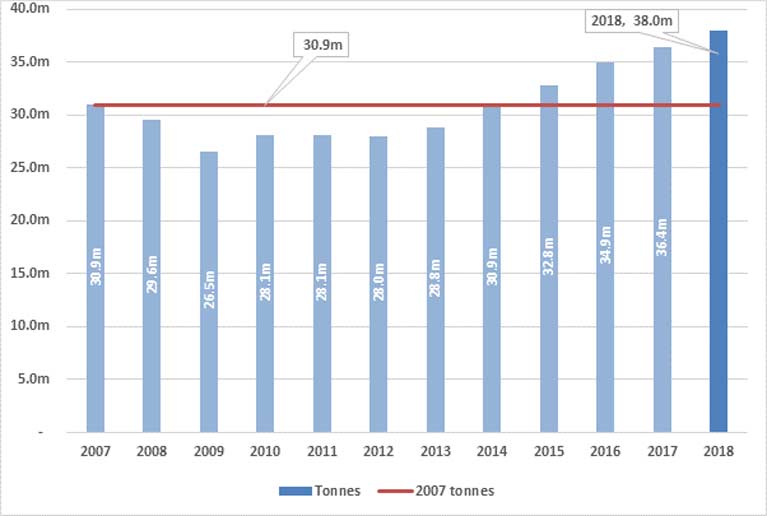 Overall Growth at Dublin Port 2007 – 2018
Overall Growth at Dublin Port 2007 – 2018
Looking at the 2018 trade figures in detail, imports grew by 5.5% to 22.7m gross tonnes while exports grew by 2.5% to 15.3 million gross tonnes. Containers and freight trailers account for 82% of all cargo and both the Ro-Ro and Lo-Lo sectors grew strongly. Ro-Ro grew by 4.0% in 2018 to over one million Ro-Ro units for the first time (1,032,000). Lo-Lo container volumes also grew by 4.0% to 726,000 TEU.
Even though national first time registrations of new trade vehicles declined by -2.5% (as reported by the CSO), imports through Dublin Port increased by +4.1% to 103,000 during 2018 suggesting an increase in Dublin Port’s share of the market for new vehicle imports.
Bulk liquid volumes, comprising mostly petroleum products, grew strongly by 7.8% to 4.6m tonnes driven by increasing activity in the road transport and aviation sectors.
Bulk solid commodities, such as animal feeds and cereals, also increased (+16.8% to 2.4m tonnes) during the year following poor weather conditions for agriculture over the previous 12 months.
Passenger volumes declined by -1.0% to 1,828,000 due to operational issues on ferries during the year. Similarly, the number of tourist vehicles declined by -1.2% to 515,000.
Dublin Port’s cruise business grew again with 150 cruise ship arrivals (compared to 127 in 2017) and growth of 32% in visitor numbers. The average size of cruise ship increased yet again reaching 50,085 gross tonnes in 2018, an increase of +10.6% compared to the previous year.
Commenting on the results, Dublin Port’s Chief Executive, Eamonn O’Reilly, said:
“Growth of 4.3% for the second year in a row is yet further confirmation that the longstanding trend of compounding annual growth in Dublin Port is back. Every year from 1993 to 2007 was a record year in Dublin Port. In the past four years we have seen this pattern re-emerge, with 2018 the fourth year in a row for record growth.
“Dublin Port’s volumes are now 23% higher than they were in 2007 before the crash. This growth has been driven by Ro-Ro freight with more than one million Ro-Ro freight units handled in 2018 for the first time ever.
“Dublin Port’s multi-million euro infrastructure investment programme continued with capital expenditure of €93m during 2018. Our investment in infrastructure is matched by our customers’ continuing investments in new ships with huge freight capacity. Even as the €149m 2,800 lanemetre W.B. Yeats enters service in Dublin Port, we are preparing for a second new Irish Ferries’ ship with 5,610 lanemetres and also for Stena Line’s 3,100 lanemetre E-Flexer, both due to enter service on the Dublin-Holyhead route during 2020.
“Dublin Port is the country’s most important port for Ireland’s import and export trades handling 84% of all containers and freight trailers in the Ro-Ro and Lo-Lo cargo modes. In recent years we have seen huge additions to shipping capacity on services linking Ireland directly to Continental Europe to the extent that two and a half times more freight already moves on direct routes to Continental Europe than goes via the UK landbridge.
“While BREXIT brings uncertainties and challenges to our business, the combination of investments by our customers and by Dublin Port is underpinned by a shared confidence in the future. Whether we are faced with a hard BREXIT or not on 29th March next will become clearer in the coming days and weeks. If we are, Dublin Port will have significant additional border inspection post capacity available for State agencies in time. Coping with the challenges of a hard BREXIT is a challenge not only for us but also for State agencies and for our customers. We will be as prepared as it is possible to be.”
Bullock 200th Lectures in Dalkey Resumes With Talk On “The Building of Bullock Harbour”
#lectures - As part of the Bullock 200 Bicentenary, as previously reported on Afloat.ie, the Bullock Harbour Preservation Association and Dublin Port Company resume a series of talks held in the Dalkey Castle and Heritage Centre.
Next week, on Tuesday, 22nd January at 8pm, a talk titled “The Building of Bullock Harbour” will be given by Elizabeth Shotton, Associate Professor at the UCD School of Architecture, Planning & Environmental Policy. Admission is free though places should be booked in advance with the Heritage Centre by emailing: [email protected]
Construction of Bulloch Harbour began in the winter of 1818/1819 by the Ballast Board (now Dublin Port Company) and in relationship to up-keep and maintenance of Bulloch Harbour involves the DPC in initiatives in conjunction with the BHPA and Dalkey Tidy Towns, see related storm damage story.
Returning to the lectures which began late last year (see below), they will continue up to May 2019 and will focus on the history and heritage of Bullock presented by excellent speakers from the Port Company and elsewhere. The lectures programme as usual will take place at 8pm in the heritage centre.
The first two lectures by Lar Joye, Port Heritage Director, and Rob Goodbody, local historian, were very well received by large audiences in the heritage centre located in Goat's Castle. The castle in Dalkey, is one of only two surviving seven fortified town houses/castles built to store cargo which were off-loaded in Dalkey during the Middle Ages, when Dalkey acted as the port for Dublin between mid-1300s to the late 1500s.
During those times, large Anglo-Norman ships could not access Dublin, as the river Liffey was silted up and navigating was notoriously difficult and dangerous leading to numerous shipwrecks. Instead vessels anchored safely in the deep waters of Dalkey Sound. When the issue of silting on the Liffey was eventually resolved, larger ships could enter Dublin which began with the expansion of the port from the late 1700's.
The Bulloch Harbour lectures have also been supported by the Dalkey Community Council, Dalkey Tidy Towns and the Dalkey Castle & Heritage Centre.
Dublin Port: How Is It Preparing For a Possible No-Deal Brexit?
#ferries - On top of the roof of Dublin Port Company's headquarters, you can see lots of building work amidst all the docked ships at the River Liffey's mouth.
And while that construction is not entirely Brexit-related, management at the port, BBC News reports, says it has to be prepared for the possibility of a no-deal and any potential economic fallout.
The UK is scheduled to leave the EU on 29 March, whether or not there is a negotiated deal. British Prime Minister Theresa May is hoping that her draft Withdrawal Agreement will get through the House of Commons, but preparations are under way in case it does not.
There is agreement across Irish society that Brexit will have an adverse effect on the country, but the worst scenario as far as the Irish government is concerned is that the UK leaves without a negotiated settlement. Politicians here refer to that option as a "hard" Brexit.
The International Monetary Fund forecasts that Ireland's economic growth would take a 4% hit "in the long run" if there is a "cliff-edge" break with the EU, because of the highly integrated nature of the Irish and UK economies.
And the independent Dublin-based think tank The Economic and Social Research Institute estimates that a "hard" Brexit could cost households up to €1,400 (£1,260) a year, because of a potential increase in food prices and possible trade tariffs.
Despite no-one in authority being in a position to predict how Brexit will unfold, the Irish government has already announced plans for an extra 1,000 customs and veterinary staff to work at Dublin and Rosslare ports and at airports, as well as new money to train people in sectors likely to be badly affected.
It has organised a series of very well-attended roadshows around the country with the involvement of state agencies with the theme "Getting Ireland Brexit Ready" for every Brexit scenario.
And there is evidence that more companies - worried about possible delays and resulting costs at Dover - are forsaking the UK land-bridge (incl. Holyhead) and for the new "Brexit-busting" super-ferries (see Afloat's report) that would sail directly between Dublin and Zeebrugge and Rotterdam, bypassing uncertainty in Britain.
It is too early to say what impact they are having, but the development is seen as significant.
There is an Irish political and economic consensus on Brexit.
For political reasons there is widespread agreement that there has to be a so-called "backstop" unless and until there is a wider trade agreement to avoid a hard border on the island of Ireland.
It is feared that such a border could risk a return to violence after a hard-won peace.
For much more click here.
Dublin Port Announces One Million Ro-Ro Freight Units in 2018
For the first time ever, Dublin Port Company has seen one million Ro-Ro freight units passing through the port within the year. The millionth freight trailer in 2018 arrived on board Irish Ferries’ Ulysses when she docked at 6.30am this morning. The truck was one of O’Toole Transport’s vehicles on board the fully booked vessel arriving from Holyhead. Every morning 13 kilometres of trucks roll off the Ro-Ro ferries arriving at Dublin Port, meeting the requirements of the retail sector and industry throughout the country.
This is the first time for Dublin Port to surpass one million Ro-Ro units in a year, and signifies continued growth in Ro-Ro freight moving through the port. Dublin Port now handles nearly 90% of Ireland’s Ro-Ro freight and the addition of the world’s largest short sea Ro-Ro ship, MV Celine, in the past year accounts for an additional 8km of freight lanes / 600 freight units alone. To date, Ro-Ro freight at Dublin Port is ahead by 4.3% compared to this time last year, and up by some 41% on boom time levels last seen in 2007.
The milestone for Dublin Port coincides with a significant week for Irish Ferries, which also sees the arrival of W.B. Yeats scheduled on Thursday, the much-anticipated new luxury ferry that will service the Dublin/Holyhead route during the Winter periods and the Dublin/Cherbourg route from mid-March to September.
Eamonn O’Reilly, Chief Executive, Dublin Port Company, said; “Today marks the one millionth Ro-Ro freight unit arriving at Dublin Port, and the milestone is significant given that Ro-Ro trailers account for more than two-thirds of the port’s overall business. It follows a period of sustained investment by Dublin Port in new infrastructure and better utilisation of lands within the port estate so that customers, such as Irish Ferries, can continue to operate to their full potential as cargo volumes rise. Our investment in port infrastructure is matched by our customers’ investment in new ships and I am delighted to see W.B. Yeats commencing operations from Dublin this week.
Andrew Sheen, Managing Director, Irish Ferries, said; “Irish Ferries has seen strong demand from customers for all our services, especially freight, in the run up to Christmas. Everything from toys and decorations to wrapping paper and wine can be found on board our vessels at this time of year, and with Dublin Port operational 24/7 there is no slowdown as we head into the New Year.”




























